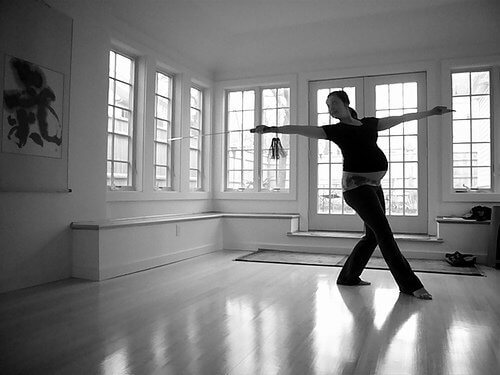Finding Freedom with Flexible Routines

Written by Stacey T, Contributing Writer
Does a “flexible routine” sound like an oxymoron? Should “freedom” and “routine” exist in the same sentence?
Routines can be pegged as being boring, rigid and stiff. But a little planning and creative thinking can help you do much more with less time and effort. A routine is different for every person but it’s a guideline to help you plan your day.
The key is to establish flexible routines which…
Provide predictability, security and confidence
Children thrive on flexible routines, and parents do too, as they provide predictability. Predictability creates security, confidence and a calm order in our homes. Children and parents like having an idea of what comes next so we all know what to expect. A little bit of structure = a lot less chaos.
Relieve stress and anxiety
Flexible routines relieve stress and anxiety because there is a plan in place. It creates a mental release from having to constantly work out the details, wondering and worrying when you’ll be able to accomplish something.
Flexible routines help us to be “pro-active” rather than “re-active.” I don’t have to stress about when I’ll return those phone calls because I have designated and set aside a time to get that done.
From experience, having a flexible routine – a backbone to the day – helps relieve my mind of having to mentally keep track of all the details of the day at once, thus giving me freedom and peace of mind.
Save energy
Energy is a valuable commodity these days – mothers can’t get enough of it! By establishing a flexible routine, you can save your precious energy. Rather than playing twenty questions about when you’re leaving for library time or answering for the 500th time how long until lunch, save your energy!
With a flexible routine, everyone in your household knows what to expect and when to expect it. And you can save your energy for when you’ll really need it, like cleaning the bathrooms.
Provides the ability to prioritize
A flexible routine allows us look at all we need and want to accomplish in a given day and to make time for those things that are of most importance. Flexible routines allow your energies to be focused and mindful. Whether the priority is having some fun with your kids or making sure that the car gets washed, working the necessities into your flexible routine ensure that they will get done.
For example, I want to spend one-on-one time with each of my children each day. Without a flexible routine, this is next to impossible most days as things always seem to crowd in and take over the time that I want to spend with them. But by establishing a routine, I know (and my kids know too!) that their special time alone with Mommy is scheduled and that it will happen!
Give the ability to accomplish and achieve more
Have you ever looked at the clock and thought, “4:00 already?! But there’s still so much that I needed to do today!”
By establishing a flexible routine, we divide our days into smaller blocks of time which helps us be more effective. When working with smaller blocks of time, you can plan varying activities in your day to ensure that you get a broad range of opportunities and experiences for you and your little ones.
Provide accountability and measure-ability
It’s easy for the days to come and go when you’re busy taking care of your family. Often you can work hard all day and not even know what you’ve accomplished as you fall into bed at night. When using a flexible routine, you can look back on what you accomplished and measure your progress.
My desire to spend quality time with each of my children can be easily tracked and measured by looking back at my routines. Some days I do better than others, but I know I’m getting somewhere and I can use this knowledge to help me improve.
Provide a rhythm
Whether we realize it or not, our lives are governed by the rhythms of life. In nature, we have cycles of years, seasons and days; the sun rises and the sun sets. Establishing a flexible routine emphasizes this rhythm which helps us feel more grounded and peaceful.
Limits TV, computer and video game time
With a flexible routine in place, TV, computer and video game time can more closely monitored. Limiting this time is important, not only for children but for us adults too. With a flexible routine, plan for the time you need on the TV, computer, etc. but also plan when to turn it off and move onto other things.

Image by ~Brenda Starr~
KEYS TO ESTABLISHING A FLEXIBLE ROUTINE:
1. Flexibility
You may notice that I consistently use “flexible routine.” This part is crucial for me. Whenever I have had an unsuccessful routine, it’s been because I’ve tried to make it too rigid and unforgiving. Don’t make rules because there are always exceptions.
Some like to live by the clock but I’ve found that too restrictive and too frustrating when things don’t go according to plan. To be honest, flexibility is the part that I struggle with the most in establishing routines. If I make my routine too rigid, I find myself frustrated and discouraged by how “real” life gets in the way of my perfect plan on paper.
Just as our backbones flex and move according to how we need our body to perform, we also need our routines to be flexible so that, as the day happens, we can move with it, adjusting and modifying as necessary, and still get the most important things done.
2. A work-in-progress
The understanding that a routine is a work in progress, and that it always will be, will help you immensely in establishing a flexible routine. Just as soon as you get on a comfortable routine that feels great, something will change which will necessitate some altering.
From day to day, month to month, season to season, your routine will provide that stability and structure that you need, but that requires nearly constant adjustments to be able to handle the changes in our lives that inevitably come.
3. Know your priorities
In order to establish a routine, priorities need to first be established. By making sure that your most important priorities are in place in your routine, you can then add other desired activities. You feel peace throughout the day knowing that you’ve got the most important things covered.
By setting your priorities, you’ll quickly and easily know what things can be let go should an unexpected circumstance, such as a child getting sick halfway through the day, throw your routine off balance. Routines to Help the Weary Mom is a great post about getting through those less-than-ideal times .
4. Be realistic
When making your routines, plan ample time for activities and errands, especially when children are involved. Always give yourself twice as much time as you think you’ll need. I’ve found that the difference between stress and calm energy is time.
There will be days when no matter how flexible your routine is, you’ll not be able to follow it. There is the ideal routine where everyone feels well, there are no surprises and everything works like clockwork. But, as we all know, life happens. A flexible routine can help you from getting discouraged because you’ll know you can adjust your routine for the next day to fit something in as needed.
5. Plan for down time
You can do anything you want, but you can’t do everything. I have to (constantly) work at maintaining a slow and simple pace at home. Otherwise I get carried away and pack too much in, which only creates stress for me and my family. Whether it be quiet times, reading times or other leisurely activities, plan some down times throughout your day.
6. Plan day-to-day rather than week-to-week
I like to make my flexible routine for the day in the morning, preferably before the kids get up. It has the same backbone as the day before but I like to plan with current circumstances in mind such as how we’re feeling, the weather, etc. I’ve found that it helps me be more flexible if I don’t have everything written in stone at the beginning of the week.
7. Use energy wisely
We hear a lot about conserving energy these days, and that applies to our mental and physical energy as well. If you know you are a morning person, then you can plan to accomplish your most difficult and most involved tasks for the morning when you are at your peak, leaving less involved tasks for the afternoon and evening. Or visa versa. Don’t set yourself up for failure if you’re a night person and make a plan to clean the entire house by 7:00 a.m. That’s just not going to work.
8. Make it your own
What works for your best friend or next door neighbor might not work for you, and that’s ok! Figure out what works best for you, your spouse and for your children and go with it. Your flexible routine might have even more flexibility in it, or you might like it more structured. You may prefer going by the clock or you might not look at the clock during the day at all. Make your flexible routine your own and enjoy what it can do for you!





I keep the overall week routine somewhat flexible. I have certain things that need to be done but I can move them around to when it’s best for our family that given week. This season of life we have very few out-of-home commitments (classes etc) as we are getting ready to move so that helps.
With homeschooling I have a definite structure to our days and like to plan blocks of time, namely morning and afternoon, but what goes into those blocks on a given day can go with the flow, as necessary.
http://fimby.tougas.net/weekly-block-planning
Excellent post. This is exactly the philosophy I have to use–flexibility within a strong framework on a solid foundation. I think the most important and difficult thing you mentioned is understanding that things change! The routine grows and changes. It’s so tempting to put up a schedule and live it, rather than living life. Also, it’s tough for us homeschooling moms of many to “do” the downtime. Thanks for that reminder! When the children were smaller, we all had Quiet Time together every day, but now that ages range from 2 to 14, that has gone by the wayside. I think I’ll bring it back.
@Christy, The Simple Homemaker,
“It’s so tempting to put up a schedule and live it, rather than living life.” Great insight! Our routines should work for us rather than making us work!
Yes, yes, yes, yes and more yes! 🙂 In other words, I completely agree. 🙂 I am exactly like you in that I plan schedules that are too rigid and then get stressed out when they don’t happen. This year I have learned so much about being flexible with our plans, but still have a general plan in place. We are big on routines now rather than schedules. We know what generally needs to happen after breakfast, before lunch etc. I do find it helpful to have what I’ve heard called “fenceposts” throughout the day. For instance, our meals, naptimes and bedtimes are run by the clock somewhat. We eat and sleep at approximately the same times each day. But the rest of the day is run more like a routine without exact times in place. Great post!
@Keri,
Thanks Keri! I really like the fencepost notion… Fairly typical mealtimes, wake times and sleep times, but room for lots of flexibility in between.
Definitely! A few months ago I made a “Weekly Task Chart” that I use to keep track of what I need to do every day to stay on top of homeschooling, cleaning, food prep, and to record any extra visitors or events for the week. One thing that I purposefully did not include were times. I know all too well that though I have goals for times to be up and doing certian activities, those times aren’t always realistic if I have been up too much at night with a child. I like having the flexibility of when to get my tasks for the day done. I notice that when I stray from following my chart, I feel really behind and overwhelmed, but when I stick to it, I feel more relaxed and freed up to enjoy downtime when I have it.
@Kristen,
I’d really like to see an example of your Weekly Task Chart, Kristen. I like the idea of knowing what the week ahead looks like without scheduling the entire week in advance and then feeling required to follow that schedule. There is such a balance to routines, plenty of flexibility yet also enough structure so it fulfills its purpose.
I have been keeping a routine recently, finally after trying for a while. It is pretty flexible and that is probably why it is working.
I found by dividing my day up (morning, afternoon, evening) that I can keep things going. I have a list of my “have too’s” for each time of day. Those are the basics that must be done to function. Then I have “want to’s” that can be skipped, bumped or changed as routine flexes with our day.
I also keep a list of weekly and monthly things that I want to accomplish. They get slotted in on the less hectic days.
I loved how you said, “I’ve found that the difference between stress and calm energy is time.” How true! I tend to try to power through the day. Hurry through our homeschool lessons. Hurry through folding the laundry. Hurry out the door. Hurry back home. Hurry to make dinner. Makes me exhausted just thinking about it!
I need to examine how I can incorporate more “time” into our daily schedule. Thanks for giving me something to think about!